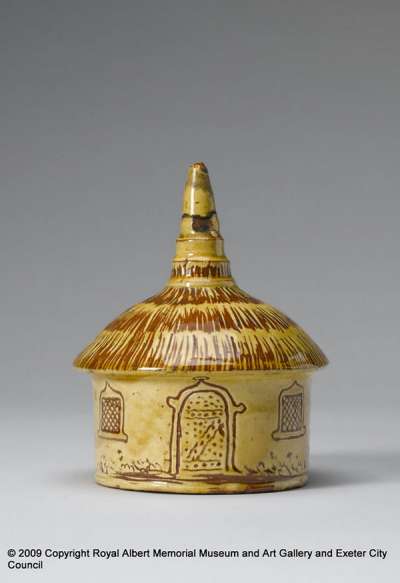Money box
This ceramic money box was made in c.1862 by a member of the Fishley family, either Edmund or his brother George. Edmund was born in 1806, Robert in 1808, to George Fishley.
George Fishley established a long lasting dynasty of potters, opening a pottery at Fremington, North Devon in 1811. Over the decades members of the Fishley family were renowned for their ceramic work. Born at Instow, just west of Fremington, in 1770, George brought up his three sons to become potters themselves. In 1839 Edmund took over the pottery and was eventually succeeded by George’s grandson Edwin Beer Fishley in 1860. Edwin continued the business until his death in 1912, when his grandson William Fishley Holland moved the pottery from Fremington to Braunton. From 1921, William worked from Clevedon in Somerset, continuing the family tradition well into the middle of the 20th century.
During the early period, the family produced everyday ware and ornamental goods, selling most of its wares locally. The natural imagery we see depicted here reflects the rural community that the Fremington Pottery served: an agricultural population who would have appreciated a rich harvest and abundance of nature. However Fremington pots were also traded outside of Devon; many of the items travelled across the sea to Cornwall and other to South Wales by way of returning coal boats. Ceramic wares were loaded onto boats at the nearby quayside on the River Taw, a place so frequently used for pottery business that it became known as ‘Fishley’s Quay’.
Fremington offered a rich supply of red clay to form the bodies of pots. Local river gravel was mixed into the clay to strengthen it and improve the durability of utilitarian ware. Imported from Wales, galena or lead sulphide was used as a glaze over the pot’s surface to give a golden yellow colour.
North Devon pottery is classified as earthenware – a form of pottery made throughout pre-industrial England. This box consists of a circular earthenware body and a domed cover in the form of a thatched roof. It has a pointed finial and pierced coin slot. A brown fabric forms the base with a cream slip added for the decoration.
Incised onto the side of the box is are the words “for GEORGE. G. FISHLEY / January 12th 1862”. (George Gregory Fishley was the eldest son of Edwin Fishley and the grandson Edmund).
The architectural features on this box, showing thatching and lancet windows, are decorated using sgraffito. Meaning ‘to scratch’ in Italian, this process involved carving into an outer layer of coloured slip to reveal the contrasting colour of the clay body beneath. In this way, a design could be incised onto the surface of the ceramic.
George Fishley established a long lasting dynasty of potters, opening a pottery at Fremington, North Devon in 1811. Over the decades members of the Fishley family were renowned for their ceramic work. Born at Instow, just west of Fremington, in 1770, George brought up his three sons to become potters themselves. In 1839 Edmund took over the pottery and was eventually succeeded by George’s grandson Edwin Beer Fishley in 1860. Edwin continued the business until his death in 1912, when his grandson William Fishley Holland moved the pottery from Fremington to Braunton. From 1921, William worked from Clevedon in Somerset, continuing the family tradition well into the middle of the 20th century.
During the early period, the family produced everyday ware and ornamental goods, selling most of its wares locally. The natural imagery we see depicted here reflects the rural community that the Fremington Pottery served: an agricultural population who would have appreciated a rich harvest and abundance of nature. However Fremington pots were also traded outside of Devon; many of the items travelled across the sea to Cornwall and other to South Wales by way of returning coal boats. Ceramic wares were loaded onto boats at the nearby quayside on the River Taw, a place so frequently used for pottery business that it became known as ‘Fishley’s Quay’.
Fremington offered a rich supply of red clay to form the bodies of pots. Local river gravel was mixed into the clay to strengthen it and improve the durability of utilitarian ware. Imported from Wales, galena or lead sulphide was used as a glaze over the pot’s surface to give a golden yellow colour.
North Devon pottery is classified as earthenware – a form of pottery made throughout pre-industrial England. This box consists of a circular earthenware body and a domed cover in the form of a thatched roof. It has a pointed finial and pierced coin slot. A brown fabric forms the base with a cream slip added for the decoration.
Incised onto the side of the box is are the words “for GEORGE. G. FISHLEY / January 12th 1862”. (George Gregory Fishley was the eldest son of Edwin Fishley and the grandson Edmund).
The architectural features on this box, showing thatching and lancet windows, are decorated using sgraffito. Meaning ‘to scratch’ in Italian, this process involved carving into an outer layer of coloured slip to reveal the contrasting colour of the clay body beneath. In this way, a design could be incised onto the surface of the ceramic.
Object Summary
- Accession Loan No.
- 107/1952
- Category
- Decorative Art
- Collection Class
- British ceramics
- Material
- earthenware
- Common Name
- money box
- Simple Name
- box
- Inscription Transcription
- GEORGE. G. FISHLEY / January 12th 1862; Fred Fishley / Fremington
- Period Classification
- Victorian (1837-1901)
- Production Town
- Fremington; Fremington
- Production County
- N Devon; N Devon
- Production Country
- United Kingdom: England; United Kingdom: England
- Production Date
- c 1862
- Production Person Initials
- Robert?; Edmund?
- Production Person Surname
- Fishley; Fishley
- Production Year Low
- 1861
- Production Year High
- 1862


